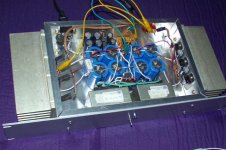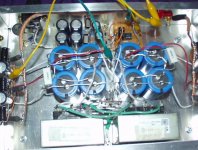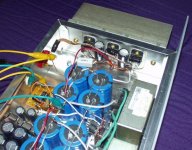Well, my bpa-200 is working. I haven't done extensive listening yet, but there is power in this amp! I used 6 of the lm3886 chips and 2 of the buyout pe tranny's per monoblock amplifier...i only have one monoblock up and running so far. I used my lm3875 amp on the R channel and this one on the L channel just for giggles, and the bpa is quite a bit more sensitive.... maybe 6db + more gain. Anyway, here are the pics. I'm still getting a bit of ground hum. Not much, but a bit. I get it when I turn the amp on (switch switches AC to tranny's)... i get hum, and when i turn the amp off (even though music still plays for a bit), the hum goes away immediately. The only things that aren't tacked down are the input gnd and input wires which are still in clip leads. I'll eventually solder everything better and make it more pretty. Comments suggestions? I also get a turn-off snap...which is not nearly as apparent if I flip the switch slowly. Hmm. Enjoy the pics 
-Matthew K. Olson
-Matthew K. Olson
Attachments
they could be causing it...who knows. Its one wire...rather than 2.. if I move the wires the hum doesn't change. It almost seems that the hum of 6 chips is the combo of whatever hum is in a single chip amp hehe. I'll keep playing w/ it and see whats up. Thanks for lookin though 
i haven't seen many of these amps here on the forum, i figured I'd build one and see if it could really be done
-Matthew K. Olson
i haven't seen many of these amps here on the forum, i figured I'd build one and see if it could really be done
-Matthew K. Olson
Have you tried to put your trafos away from the amp case?
shure that GND is exempt from any kind of loops?
I had some hum problems with some undesired connections of the AC power to the amp case (and so the GND). Some chips where not perfectly isolated from the case and this was causing hum.
Actually I prefer to use the lm3886 with plastic case, and I have the a quieter amp.
HTH
shure that GND is exempt from any kind of loops?
I had some hum problems with some undesired connections of the AC power to the amp case (and so the GND). Some chips where not perfectly isolated from the case and this was causing hum.
Actually I prefer to use the lm3886 with plastic case, and I have the a quieter amp.
HTH
Looking at the pics, it seams that those two trafos are single voltage, that's fine.
But I only see one rectifier board.
What diodes are you using on the PSU?
Because the MUR860s are not enough to feed 6 chips.
Now the hummmmm...
You have 3 chips in each side of the amp.
That's not the way to do it, you have a big ground wire that travels from side to side.
Actually, you should have the 6 chips toguether, and the layout should be as tight as possible.
Otherwise... hummmmmmmm...
But I only see one rectifier board.
What diodes are you using on the PSU?
Because the MUR860s are not enough to feed 6 chips.
Now the hummmmm...
You have 3 chips in each side of the amp.
That's not the way to do it, you have a big ground wire that travels from side to side.
Actually, you should have the 6 chips toguether, and the layout should be as tight as possible.
Otherwise... hummmmmmmm...
No i'm not sure the gnd is exempt from loops. The amp case is grounded to earth, but the power gnd is not attached to the case...the hum gets much much worse if I do that. I could try moving the tranny's away, but that defeats the purpose of the amp...i was going for something small...just for the heck of it. I am using the lm3886's w/ plastic case. 
thanks for the suggestions though
-Matthew K. Olson
ps, i think the switch is causing the popps... its only a 6A rated switch... i'm using a 3A inrush current limiter though... who knows
thanks for the suggestions though
-Matthew K. Olson
ps, i think the switch is causing the popps... its only a 6A rated switch... i'm using a 3A inrush current limiter though... who knows
Yes, i'm only using the mur860's.  hehe fire just seemed like a more elegant solution than a big fat bridge ... oh well.
hehe fire just seemed like a more elegant solution than a big fat bridge ... oh well.
As for the 6 chips being together, yes, I aggree...but the heatsinks I had didn't exactly uh, warrant that. But its a good point. The schematic and pcb I designed for this (which is still on the drawing board) had all 6 in a row. Anyway, guess I'll get em next time!
-Matthew K. Olson
 hehe fire just seemed like a more elegant solution than a big fat bridge ... oh well.
hehe fire just seemed like a more elegant solution than a big fat bridge ... oh well. As for the 6 chips being together, yes, I aggree...but the heatsinks I had didn't exactly uh, warrant that. But its a good point. The schematic and pcb I designed for this (which is still on the drawing board) had all 6 in a row. Anyway, guess I'll get em next time!
-Matthew K. Olson
rail voltage is 27+-. The sinks get warm but not hot. The amp does distort at higher volume levels. I'm running them into 8 ohm speakers, and it doesn't seem like they are putting out the 150-200 wpc that I was expecting. Too small of a bridge? Too small a PS? The gain is high though 
-Matthew K. Olson
-Matthew K. Olson
Mattyo5 said:[snip]and it doesn't seem like they are putting out the 150-200 wpc that I was expecting.[snip]-Matthew K. Olson
How do you know?
Jan Didden
How do I know, well, i had anthony holton's symmetrical 400's running at 70v rails....approx 200 wpc. No matter how high I cranked it...no distortion...my ears gave out before the amps. This amp, no where near that level. Maybe 100 wpc is more like it... but good point, i have no objective test right yet.
-Matthew K. Olson
-Matthew K. Olson
Well, i hope thats not it, but I have a sneaky suspision that it is the limiting factor. The reason I hope its not a big factor is that i wanted to keep these chassis small...and putting a big fat toroidal in there would be way cool, but difficult and way to packed as far as spacing goes.
-Matthew K. Olson
-Matthew K. Olson
For 180W, your mains transformer should be >300VA.
The ICs will also clip the output if they get too hot.
Dont test the heatsinks to see how hot they are... test the amp ICs.
If you burn your finger on them, then they are probably too hot.
A bridged LM3886 amp i made a while back (42V rails), started clipping at 40W RMS output power.
As soon as i removed the mica insulating washers the LM3886s could then keep cool and i got the full 220W RMS out.
The ICs will also clip the output if they get too hot.
Dont test the heatsinks to see how hot they are... test the amp ICs.
If you burn your finger on them, then they are probably too hot.
A bridged LM3886 amp i made a while back (42V rails), started clipping at 40W RMS output power.
As soon as i removed the mica insulating washers the LM3886s could then keep cool and i got the full 220W RMS out.
Well, those trannys are supposedly 200va each in parallel. I'll have to use an IR gun to see the temp of the chips. One of the reasons I used 3 chips in parallel is for spreading of the heat better than 2 chips, but they are plastic package. ... More testing needed 
-Matthew K. Olson
-Matthew K. Olson
One of the reasons I used 3 chips in parallel is for spreading of the heat better than 2 chips, but they are plastic package. ... More testing needed[/B]
Oh... well thats probably it then.
The TF packages are no good at higher power levels.
Mattyo5 said:How do I know, well, i had anthony holton's symmetrical 400's running at 70v rails....approx 200 wpc. No matter how high I cranked it...no distortion...my ears gave out before the amps. This amp, no where near that level. Maybe 100 wpc is more like it... but good point, i have no objective test right yet.
-Matthew K. Olson
Yes, the difference between 100W and 200W is just 3dB, which is considered barely detectable by the average listener (not to imply that you are avarage
So, before you start replacing parts and transformers and whatnot, it would pay to measure the undistorted output voltage with a load resistor on a scope & multimeter, to have at least some idea of what's up.
Jan Didden
- Home
- Amplifiers
- Chip Amps
- BPA-200 w/ six chips working w/ pics!


